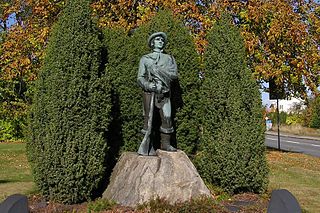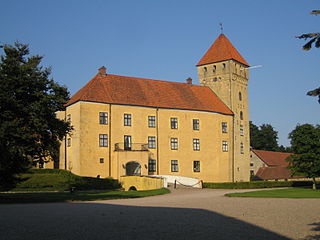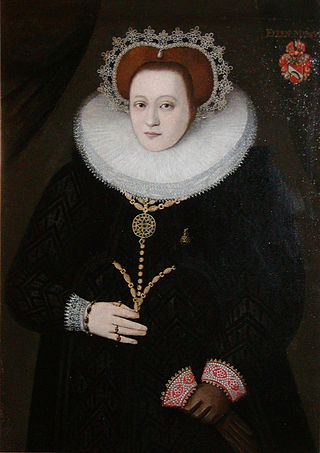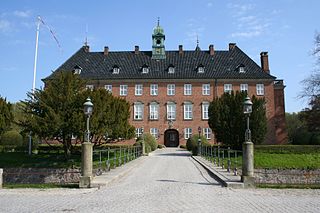Related Research Articles

Skåneland or Skånelandene (Danish) is a region on the southern Scandinavian peninsula. It includes the Swedish provinces of Blekinge, Halland, and Scania. The Danish island of Bornholm is traditionally also included. Skåneland has no official recognition or function and the term is not in common usage. Equivalent terms in English and Latin are "the Scanian Provinces" and "Terrae Scaniae" respectively. The term is mostly used in historical contexts and not in daily speech. In Danish, Skånelandene is used more often. The terms have no political implications as the region is not a political entity but a cultural region, without officially established administrative borders.

Niels Juel was a Danish admiral and naval hero. He served as supreme command of the Dano-Norwegian Navy during the late 17th century and oversaw development of the Danish-Norwegian Navy.

The Count's Feud, sometimes referred to as the Count's War, was a Danish war of succession occurring from 1534 to 1536, which gave rise to the Reformation in Denmark. In the broader international context, it was a part of the European wars of religion. The Count's Feud derives its name from the Protestant Count, Christopher of Oldenburg, who championed the claim to the throne of the deposed Catholic King, Christian II, rejecting Christian III's election. Christian III was a devoted Protestant who had already established Lutheranism as the state religion in Schleswig and Holstein by 1528.

The Scanian War was a part of the Northern Wars involving the union of Denmark–Norway, Brandenburg and Sweden. It was fought from 1675 to 1679 mainly on Scanian soil, in the former Danish–Norwegian provinces along the border with Sweden, and in Northern Germany. While the latter battles are regarded as a theater of the Scanian war in English, Danish, Norwegian and Swedish historiography, they are seen as a separate war in German historiography, called the Swedish-Brandenburgian War.

A snapphane was a member of a 17th-century pro-Danish guerrilla organization, auxiliaries or paramilitary troops that fought against the Swedes in the Second Northern and Scanian Wars, primarily in the eastern former Danish provinces that had become southern Sweden in these wars. The term was a derogatory reference for those the Swedish authorities considered illegal combatants.

Marsvinsholm Castle is situated in Ystad Municipality, Scania, in southern Sweden, 12 kilometres (7.5 mi) from Ystad.

Peder Pedersen Winstrup was Bishop of Lund in Scania. Winstrup was bishop there during a period spanning both Danish and Swedish sovereignty and periods of war when the land was contested. He was married to the Danish noblewoman, Dorothea von Andersen who was an influential person in her own right in Scania and known to be strongly pro-Danish.

Hovdala Castle is a castle in Hässleholm Municipality, Scania, in southern Sweden. Its oldest visible parts date from the early 16th century although the original construction dates back to at least the early 12th century.

Krageholm Castle is an estate at Ystad Municipality in Scania, Sweden.

Tosterup Castle is a castle in Tomelilla Municipality, Scania, in southern Sweden. It is situated approximately 12 kilometres (7.5 mi) north-east of Ystad.

Ellen Marsvin was a Danish noble, landowner and county administrator. She was the mother-in-law of King Christian IV of Denmark-Norway, the mother of Kirsten Munk (1598–1658) and grandmother of Leonora Christina Ulfeldt (1621–1698).

Iver Eriksen Rosenkrantz was a Danish statesman and landowner.

Vemmetofte Convent is a former manor house in Faxe Municipality south of Copenhagen, Denmark. It was turned into a convent by Princess Sophia Hedwig of Denmark in 1735. Since 1975 it has provided housing available to the general public.
Birgitte "Brita" Scheel (1638–1699), was a Danish noblewoman who married a Danish nobleman who became Swedish with the annexation of Denmark's eastern provinces. For that reason, Birgitte belongs both to Danish and Swedish history, and her family lives on in the now Swedish province of Scania (Skåne).

Niels Trolle til Trollesholm og Gavnø was a Danish nobleman who served as vice admiral under Christian IV and later as Steward of Norway from 1656 to 1661. He played a central administrative role during the Nordic War.
Iver Krabbe was a Danish nobleman, military officer, and governor-general in Norway.

Ove Ramel was a Danish landowner and administrator.
Baron Jörgen Iversen Krabbe of Krogholm Castle (1633–1678) was a Danish jurist and later a Swedish nobleman, who was one of the most influential men in the province of Scania and played an important role during the Scanian War of 1676–1679. He was executed by the Swedes for high treason.
Jørgen Müller (1648–1695) was a Dano-Norwegian government official. He served as the County Governor of Nedenæs county from 1681 until 1691. He was born in Copenhagen, Denmark in 1648 to Henrik Müller and Sophie Hansdatter. In 1682, he married Karen Henningsdatter Pogwisch, the daughter of Henning Pogwisch.
Jens Mikkelsen Ehrenborg was a Danish soldier and public servant who later became a Swedish nobleman. He was born in 1621 in Fredericia in southern Jutland in Denmark. His name was also spelled Jöns Michelsson, Jens Michelsen or Jöns Michaelson. Upon his ennoblement in 1687, he was given the surname Ehrenborg.
References
- ↑ Bricka, Carl Frederik. "225 (Dansk biografisk Lexikon / VIII. Bind. Holst - Juul)". runeberg.org (in Danish). Retrieved 2021-04-25.
- ↑ no:Karen Iversdatter Krabbe#cite ref-2
- ↑ Jojan Vadenbring"'Om vi blifver svensk': Identitetsfrågor i övergångstid" pp. 179 in Harald Gustafsson & Hanne Sanders (eds.),Integration och identiteter i det förnationella Norden, Göteborg 2010, English Summary, p.177
- ↑ no:Norsk biografisk leksikon
- ↑ Knud Fabricius, Skaanes overgang fra Danmark til Sverige, vol I, Copenhagen 1906, p.45
- ↑ Fabricius, vol. III, Copenhagen 1952, p.86-87
- ↑ Tor Weidling, Eneveldets menn i Norge: Sivile sentralorganer og embetsmenn 1660-1814, Oslo 2000, p.205
- ↑ Histoire des Negotiations des Nimegue, Alexandre-Toussaint Limojon de Saint-Disdier, Paris 1680, pp.15-20
- ↑ Vadenbring, p.164 and p.179.
- ↑ Histoire des Negotiations des Nimegue, Alexandre-Toussaint Limojon de Saint-Disdier, Paris 1680, p.20
- ↑ Samuel Loenbom, Lars Salvii, Handlingar til konung Carl XI:tes historia, Stockholm 1763, p.50
- ↑ Aletophilus (Olluf Rosencrantz), En sandfärdig Repliqve, Malmö 1678
- ↑ Disdier, p.20
- ↑ Weidling, Tor. Eneveldets menn i Norge: Sivile sentralorganer og embetsmenn 1660-1814,Oslo 2000, p. 205
- ↑ Dansk biografisk Lexikon, fra https://runeberg.org/dbl/8/0227.html